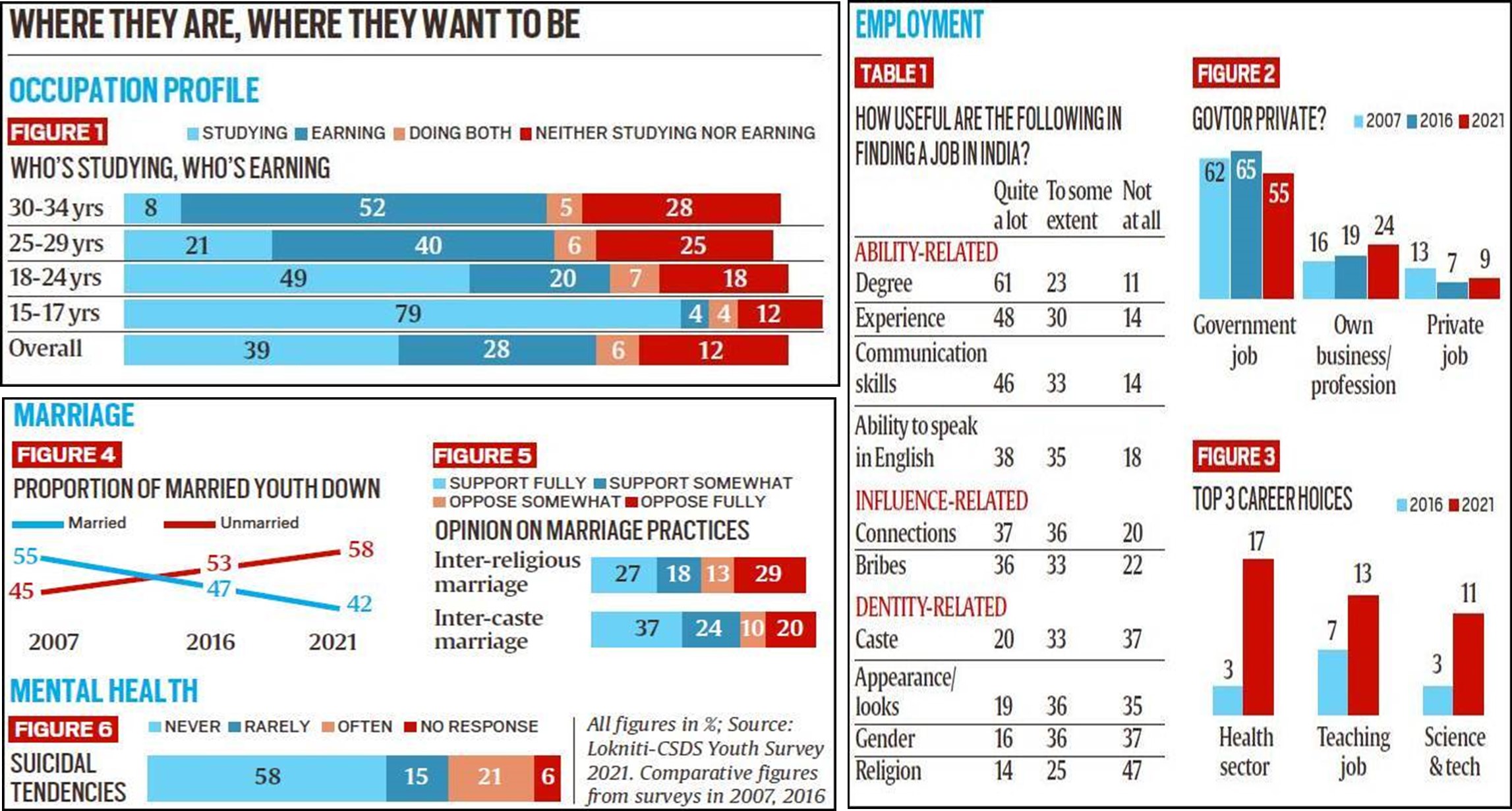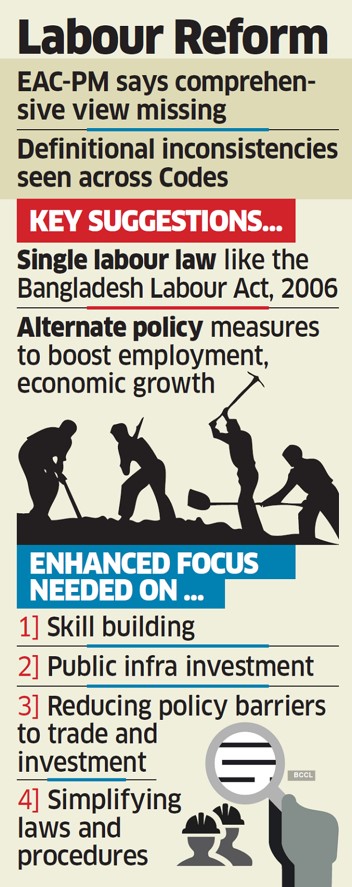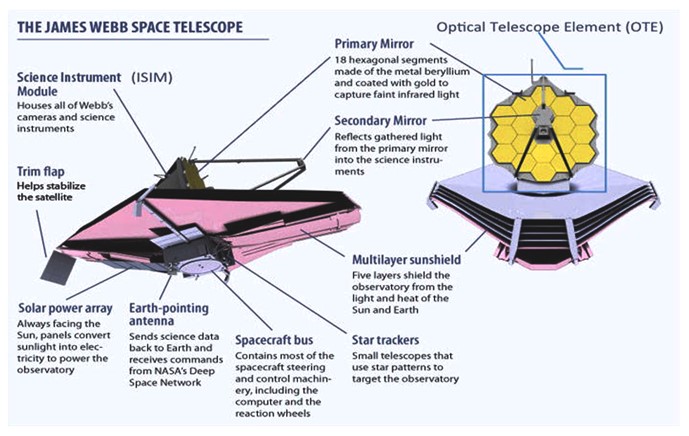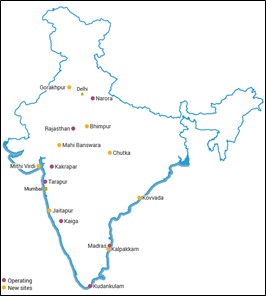Friday, 24th December 2021
Lokniti Report on the youth of India
In News
A recent report released by Lokniti-CSDS, offers insights on the career aspirations, job preferences and expectations of young India aged 15-34, as well as their opinions on institutions of kinship, and their mental health.
Findings of the Report
- Occupation status:
- Two-fifths of the youth identify themselves as students, 7% higher than 2016.
- Although a higher proportion of males (40%) were working than females (10%), more females were studying than men.
- The data indicated higher enrolment in higher education with close to half of the youth in the 18-24 group studying and only one in five earning.
- Youth identified ability-related characteristics (qualification, experience and communication) as important in finding a job, rather than identity-related factors.
- Employment:
- Indicating changing priorities, about half (55%) said they would prefer a government job as compared to 65% in 2016; a quarter (24%) would prefer to start their own business.
- Probably due to the ongoing pandemic, there was a rise from 3% to 17% among those wanting to join the health sector as doctors, nurses or other medical staff.
- Marriage:
- The proportion of married youth has decreased by 13% since 2007 and 5% since 2016.
- Youth showed a greater acceptance for the idea of inter-caste marriage than for inter-religious marriage.
- Mental health:
- The study found that the family’s financial security worried the youth the most, followed by their own health.
- More than half worried about their physical appearance (54%) and their job (56%).
- About half each reported feeling sad, losing interest in daily activities, and being affected by loneliness during the last two or three years. Also, those with high exposure to social media were found to be more emotionally distressed than those with low or no exposure.
- Highlighting the importance of family in the Indian context, 65% said they will approach either a family member or relatives if struggling with depression or thoughts of ending their life.
- Only 3% said they would approach a mental health professional, indicating the social stigma and the negative stereotyping of people with mental health issues. 9% said they would not approach anyone.
- Religious values:
- Respect for religious and cultural difference, celebration of the attitude of living together separately and an aspiration for a good society based on economic equality are some of the contemporary values important for the youth today.
- More Sikh youths prayed regularly than youth from any other religion.
- Around 50 per cent of the overall respondents supported a ban on stand-up comedy on any religion, while only a third (32 per cent) opposed it and 18 per cent had no response.

Conclusion: The youth constitute a third of the Indian population. Such a large young population is an asset for any nation as they have the potential to play an active role in shaping the socio-economic and political development of the country. But today, young Indians are grappling with multiple challenges. Yet, there are positive notes to glean from the findings, for e.g., a rising aspiration among the youth to start their own business. On the other hand, it is important to ensure that there is general mental health awareness and also access to mental healthcare.
Sources:
CAG Report on Indian Railways
In New
In a report tabled in Lok Sabha, the CAG said that the zonal railways administration has recorded excess expenditure against sanctioned estimates and expenditure without detailed estimates.
What are the major findings of the report?

Recommendations of the CAG for Indian Railways
- Ministry of Railways needs to take steps to diversify their freight basket to enhance freight earnings and also consider to exploit its idle assets to increase other earnings.
- It needs to take steps to augment their internal revenues, so that dependence on GBS and EBR is contained.
- It needs to revisit the passenger and other coaching tariffs so as to recover the cost of operations in a phased manner and reduce its losses in its core activities.
- It needs to ensure that surplus and Operating Ratio represent a true picture of its financial performance.
- It needs to address the backlog of renewal of over-aged assets for safe running of trains.
- It may consider speeding up the winding-up process of non-working Railway PSUs.
- It may consider framing strategic IT plan at macro level instead of ad-hoc development of applications.
Sources:
Unified Labour Law
In News
The Economic Advisory Council to the PM (EAC-PM) has recently proposed a unified labour code.
About the News
- The EAC has proposed the unified law much on the lines of the Bangladesh Labour Act of 2006, stating that the labour reforms undertaken in form of four Codes has not taken a comprehensive view of all labour laws and had only standardised and streamlined the existing statutes without addressing definitional inconsistencies.
- The Bangladesh Labour Act 2006 comprehensively covers conditions of service and employment, youth employment, maternity benefit, health hygiene, safety and welfare of workers, trade unions, industrial relations, disputes labour court, provident funds etc.
- As per the EAC, a 'single unified labour law' or reforms will focus on all sectors and nature of jobs. This would create a supportive business environment for the urban economy. This would allow the service sector and the new-age urban economy to perform better.

Current Status of Labour Code in India
The union labour ministry had amalgamated 29 central labour laws into four Codes.
- The Code on Wages, 2019: applies to all the employees in both organized and unorganized sector and aims at providing equal remuneration to employees performing work of a similar nature in every industry, trade, business, or manufacture.
- The Code on Occupational Safety, Health and Working Conditions, 2020: seeks to regulate the health and safety conditions of workers in establishments with 10 or more workers, and in all mines and docks.
- The Code on Social Security, 2020: consolidates nine laws related to social security and maternity benefits.
- The Code on Industrial Relations, 2020: seeks to consolidate three labour laws namely, The Industrial Disputes Act, 1947: The Trade Unions Act, 1926 and The Industrial Employment (Standing Orders) Act, 1946 to improve the business environment in the country largely by reducing the labour compliance burden of industries.
Source:
- Economic Advisory Council to the PM calls for unified labour law
- New Labour Codes: How will they impact social security, take-home salary
Image Source:
National Consumer Rights Day 2021
On December 24, 1986 the Consumer Protection Act received assent of the President of India. December 24 is celebrated annually in India as National Consumer Rights Day, also called National Consumer Day. The purpose of the day is to make consumers aware of their rights and responsibilities. A consumer is anyone who purchases goods or services, and pays for it in return. Consumer Protection Act guarantees six basic rights to consumers: right to choose the product; right to be protected from all kinds of hazardous goods; right to be informed about the performance and quality of all products; right to be heard in all decision-making processes related to consumer interests; right to seek redressal, whenever consumer rights have been infringed; right to complete consumer education.

Source:
James Webb Space Telescope (JWST)
In News
NASA has announced to launch the James Webb Space Telescope (JWST) on December 25, 2021.
About JWST
- JWST is a facility-class space observatory operating in the visible, near and mid infrared wavelengths (0.6 - 28.5 microns). It is proposed as the successor to the Hubble Space Telescope (HST).

- It is a joint project of NASA, the European Space Agency (ESA) and the Canadian Space Agency (CSA).
- It will orbit the Sun in a Lissajous pattern around the second Lagrangian point (L2), 5 million km from Earth.
- Lagrange Points are positions in space where the gravitational forces of a two body system like the Sun and the Earth produce enhanced regions of attraction and repulsion. These can be used by spacecraft to reduce fuel consumption needed to remain in position.
- The telescope is designed primarily to detect light in the infrared in order to observe sources such as the first galaxies and protostars that radiate at those wavelengths.

The JWST Tools
- The Observatory of the JWST is comprised of three elements: the Integrated Science Instrument Module (ISIM), the Optical Telescope Element (OTE), which includes the mirrors, and backplane, and the Spacecraft Element, which includes the Spacecraft Bus and Sunshield.
- The ISIM includes the four instruments, each specially designed to study different aspects of infrared light.
The Science Goals of JWST Mission and their Significance
The science goals for the Webb can be grouped into four themes:
- The End of the Dark Ages: First Light and Reionization- It will peer back over 13.5 billion years to see the first stars and galaxies forming out of the darkness of the early universe.
- Assembly of Galaxies- JWST's unprecedented infrared sensitivity will help astronomers to compare the faintest, earliest galaxies to today's grand spirals and ellipticals, helping us to understand how galaxies assemble over billions of years.
- The Birth of Stars and Protoplanetary Systems- JWST will be able to see right through and into massive clouds of dust that are opaque to visible-light observatories like Hubble, where stars and planetary systems are being born.
- Planetary Systems and the Origins of Life- JWST will tell us more about the atmospheres of extrasolar planets, and perhaps even find the building blocks of life elsewhere in the universe. In addition to other planetary systems, JWST will also study objects within our own Solar System.

What are the new technological innovations being used in JWST?
- Mirror: A telescope's sensitivity, or how much detail it can see, is directly related to the size of the mirror area that collects light from the objects being observed. Webb's primary mirror is 6.5 meters across; a mirror this large has never before been launched into space.
- Hexagonal Shape of Mirrors: The hexagonal shape allows for a roughly circular, segmented mirror with "high filling factor and six-fold symmetry."
- Use of Beryllium: In particular, beryllium is very strong for its weight and is good at holding its shape across a range of temperatures including at cryogenic temperatures. Beryllium is a good conductor of electricity and heat, and is not magnetic.

- The microshutters: The microshutters are a new technology that was developed for the JWST mission. They are basically tiny windows with shutters that each measure 100 by 200 microns, or about the size of a bundle of only a few human hairs. The speciality of microshutter device is that it can select many objects in one viewing for simultaneous observation and it is programmable for any field of objects in the sky.
- No other spectroscopic instruments have had the capability to enable high-resolution (spectroscopic) observation of up to 100 objects simultaneously, which means much more scientific investigating can get done in less time.
- Other key innovations include Lightweight optics, Deployable sunshield, Folding segmented mirror, Improved Detectors and Cryogenic actuators & mirror control.
How will Webb be better than the Hubble Space Telescope?
- Webb is designed to look deeper into space to see the earliest stars and galaxies that formed in the Universe and to look deep into nearby dust clouds to study the formation of stars and planets. In order to do this, Webb will have a much larger primary mirror than Hubble (2.7 times larger in diameter, or about 6 times larger in area), giving it more light-gathering power.
- It also will have infrared instruments with longer wavelength coverage and greatly improved sensitivity than Hubble.
- Webb will operate much farther from Earth, maintaining its extremely cold operating temperature, stable pointing and higher observing efficiency than with the Earth-orbiting Hubble.
Question: James Webb Space Telescope will be a giant leap forward in our quest to understand the Universe and our origins. Justify.
Sources:
- The James Webb Space Telescope Observatory
- Explained: NASA’s flagship telescope, and its successor
- Webb's Mirrors
- Frequently Asked Questions
- Webb vs Hubble Telescope
- James Webb Space Telescope Science
- Webb Project Timeline
- What’s in Webb’s Toolkit?
- James Webb Space Telescope: How our launch of world’s most complex observatory will rest on a nail-biting knife edge
- JAMES WEBB SPACE TELESCOPE: WHY IT'S A BIG DEAL, HOW IT WORKS, AND WHAT HAPPENS NEXT
- Infrared Astronomy
- Fast facts about the James Webb Space Telescope
- James Webb Space Telescope
ISS pass over Rome's Colosseum
This is image of the ISS transiting over the Colosseum in Rome. It is a "once in a lifetime" event. The International Space Station is tricky to photograph from down on Earth. The station zips along at about 17,500 mph (28,000 km/h) and it's a small dot of light when spotted from below. The Colosseum is nearly 2,000 years old. The International Space Station (ISS) is a multi-nation construction project that is the largest single structure humans ever put into space. Its main construction was completed between 1998 and 2011, although the station continually evolves to include new missions and experiments. It has been continuously occupied since Nov. 2, 2000. The ISS is not owned by one single nation and is a “co-operative programme” between Europe, the United States, Russia, Canada and Japan, according to the European Space Agency (ESA).

Source:
Artificial Sun
- Context: China has conducted a nuclear fusion experiment towards the advancement of its ''artificial sun.''
- The Hefei Institute of Physical Science kicked off the Experimental Advanced Superconducting Tokamak (EAST) heating system this month as per state media Xinhua News Agency.
- The experiment aims at making the artificial sun or the auxiliary heating system ''hotter'' and more ''durable.''
- China has already spent around 6 billion yuan ($893 million) on a large doughnut-shaped installation known as a tokamak, which uses extremely high temperatures to boil hydrogen isotopes into a plasma, fusing them together and releasing energy.
- If that energy can be utilised, it will require only tiny amounts of fuel and create virtually no radioactive waste.
- China has been researching fusion since 1958, but at the current stage, it is still more about international cooperation than competition, Song said. The country is a member of the 35-nation ITER project, a 10-billion euro ($11.29 billion) fusion project under construction in France.
- ITER is scheduled to generate first plasma by 2025. A demonstration reactor will then be built, with the aim of creating 500 megawatts of power from just 50 megawatts of input, a tenfold return on energy.

Source:
High-speed Expendable Aerial Target (HEAT) Abhyas
- Context: The DRDO has recently successfully conducted the flight test of indigenously developed HEAT Abhyas from Integrated Test Range (ITR).
- Two boosters provided initial acceleration during launch and a small turbo jet engine is used to sustain high subsonic speed with long endurance.
- Aeronautical Development Establishment (ADE), Bengaluru based DRDO laboratory along with other DRDO laboratories has developed this indigenous unmanned aerial target system to meet the requirement of aerial targets of Indian Armed Forces.
- The aircraft is controlled by a navigation system operated with the help of a flight control computer.
- The development may be viewed as a step in the direction of achieving self-reliance in defence, in line with the government's Aatmanirbhar Bharat policy.

Source:
Vernacular Innovation Programme
- Context: The Atal Innovation Mission (AIM) under the NITI Aayog has recently developed a vernacular innovation program (VIP).
- Vernacular Innovation Programme enables innovators and entrepreneurs in India to have access to the innovation ecosystem in 22 scheduled languages.
- Under the programme, AIM will train a vernacular task force (VTF) in each of the 22 scheduled languages with each task force consisting of vernacular language teachers, subject experts and technical writers.
- Vernacular innovation program strengthens the design and innovation capabilities of our communities, thereby assisting local entrepreneurs, artisans and innovators to seamlessly assimilate the knowledge cum technical materials that AIM will develop.
- India may be the first nation in the world to launch such an initiative where an innovation ecosystem catering to 22 languages plus English is being built.

Source:
- Niti launches vernacular innovation programme in 22 languages for entrepreneurs
- Vernacular Innovation Program
Image Source:
Reintroduced gharials in Beas reserve
- Context: Gharial have been reintroduced in the beas river in Punjab.
- Gharial (Gavialis Gangeticus) also known as the gavial or the fish-eating crocodile belongs to family Gavialidae and among the longest of all living crocodilians.
- Adult males have a distinct boss at the end of the snout, which resembles an earthenware pot known as a ghara and so the name “gharial”.
- The gharial is well adapted to catching fish because of its long, thin snout and 110 sharp, interlocking teeth.
- It is found to inhabit fresh waters of the northern India like Chambal river, Ghagra, Gandak river and the Sone river.
- It is categorised as Critically Endangered in IUCN Red List and is listed on Appendix I of CITES and Schedule I of the Wild Life (Protection) Act, 1972.

Source:
Image Source:
Sustaining growth after pent-up demand fades: IE
Essence: The article talks about the disruptive phase from which the economy is trying to cope up and it subsequent path to recovery. Though there are evidences supporting the rise of inequalities. But, at the same time evidences are also indicating the rise in demand. With vaccination rate rising, there is also rise in demand for goods and services. This pent up demand has the potential to trickle down, if a new wave of Covid-19 can be mitigated. India’s high skill exports and tech startup are performing well, but one cannot be certain that they might be able to fill the gap due to fading pent up demand.
This entire situation creates an opportunity for public policy to step in which will set the stage for sustaining the growth. The policy should be such that it should be the source of stability and predictability accompanied with the proper implementation of it. The economy has to brace itself to use the period of fueled pent up demand efficiently which could set the stage for continued strong growth.
Why you should read this article?
- To understand the atrocities caused by the pandemic in the economy.
- To understand the concept of pent-up demand
- To understand how the policy framework should be designed in order to sustain the continued growth.
Source:
As a regional leader, not a victim of circumstance: TH
Essence: The editorial focuses on external threats, blindsided diplomacy and India’s perception in the South Asia geopolitics. Firstly, with the onset of corona pandemic, USA’s withdrawal and China’s dominance in the region, India has received many threats and couldn’t forsee them, even during Doha talks or Troika Plus dialogue. The unplanned Afghanistan strategy leads India in a vulnerable spot for bilateral ties with Afghanistan for present and future.
Reluctance to accept that there have been Chinese intrusions (which is proven through satellite images and international media), India needs to understand the strategic impact of increased China’s forceful behavior along the border- restrict in building border infrastructure, accelerating CPEC project, stopping India from reclaiming disputed land, etc.
India needs to improve its image with its neighbors (which failed by not being able to provide promised vaccines), so that South Asian neighbors could rely on India during tough times. It is an imperative for India not to paint its image as a victim of circumstances but an arbiter of its own destiny and the region.
Why you should read this article?
- To understand the near-term threats for India in the subcontinent region.
- To understand the diplomatic misses and mistakes which need urgent reformation.
Source:
Needed, a public health data architecture for India: TH
Essence: The editorial highlights the issue of data collection and surveys in health system in India. The NFHS, in initiated in the year 1992-93, conducts survey in repeated intervals of 4-5 years. It provides district level information on fertility, child mortality, reproductive and child health, with the respondents being women (15-49 years) and husbands included. The survey has included many inter-related and new parameters for data collection- tobacco, alcohol, vitamin D3, HIV, etc. The survey, being the primary reliance for policy making, has become huge in size, with women survey containing 93 pages (1100+ questions) and men survey containing 38 pages (800+ questions).
The idea must be to increase the number of surveys in themed verticals in India. This would reduce the duplication of data, include wider parameters, avoid confusion with research vs program monitoring and implementation, etc.
India has the capacity to conduct largescale surveys with computer-assisted interviews and quick turnaround. What is needed is a political will to initiate an integrated and organized setup for public health data architecture in India.
Why you should read this article?
- To understand the history, scope and outreach of NFHS.
- To relate to the issues that NFHS goes through and reforms required.
Source:
Eat Right Initiative
Background
- In India, the full burden of food borne illnesses is not known; most food borne illnesses go unreported like age old problem of poor environmental sanitation, lack of access to safe water and poor disease surveillance.
- Bhubaneswar railway station has been certified as “Eat Right Station” for providing high-quality, nutritious food to passengers.

How Certification can be invaluable to any business/governance?
- ‘Eat Right Station’ certificate was awarded to the Bhubaneswar station after an audit conducted by a FSSAI.
- The “Eat Right Station” certification was part of the Eat Right India movement. It is an effort made by Food Safety and Standards Authority of India to transform the food system in India with an aim to ensure safe, healthy and sustainable food for all Indians.
- The Eat Right India adopts regulatory, capacity building, collaborative and empowerment approaches in ensuring that the food available is suitable for people as well as for the planet.
- The Eat Right India adopts regulatory, capacity building, collaborative and empowerment approaches in ensuring that the food available is suitable for people as well as for planet.
- The award makes us more responsible to maintain this standard of hygienic and quality food for our valued passengers in future
Quote: "The goal of the food safety professional should be to create a food safety culture, not a food safety program."
Source:
Share the article
Get Latest Updates on Offers, Event dates, and free Mentorship sessions.

Get in touch with our Expert Academic Counsellors 👋
Frequently Asked Questions
UPSC Daily Current Affairs focuses on learning current events on a daily basis. An aspirant needs to study regular and updated information about current events, news, and relevant topics that are important for UPSC aspirants. It covers national and international affairs, government policies, socio-economic issues, science and technology advancements, and more.
UPSC Daily Current Affairs provides aspirants with a concise and comprehensive overview of the latest happenings and developments across various fields. It helps aspirants stay updated with current affairs and provides them with valuable insights and analysis, which are essential for answering questions in the UPSC examinations. It enhances their knowledge, analytical skills, and ability to connect current affairs with the UPSC syllabus.
UPSC Daily Current Affairs covers a wide range of topics, including politics, economics, science and technology, environment, social issues, governance, international relations, and more. It offers news summaries, in-depth analyses, editorials, opinion pieces, and relevant study materials. It also provides practice questions and quizzes to help aspirants test their understanding of current affairs.
Edukemy's UPSC Daily Current Affairs can be accessed through:
- UPSC Daily Current Affairs can be accessed through Current Affairs tab at the top of the Main Page of Edukemy.
- Edukemy Mobile app: The Daily Current Affairs can also be access through Edukemy Mobile App.
- Social media: Follow Edukemy’s official social media accounts or pages that provide UPSC Daily Current Affairs updates, including Facebook, Twitter, or Telegram channels.






